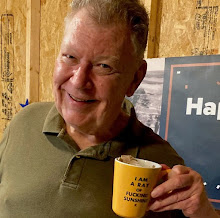 |
| That's a wrap. |
Some of you figured this out before I did. The last post on this blog was August 4th, more than two months ago. I've never posted on a regular schedule, but two months is a long break. I knew I was wrestling with some things and didn't know what my next move would be. I don't have all the answers, no one ever does, but here is what I know now.
I am discontinuing The Bourbon Country Reader, effective immediately. The last issue was Volume 23, Number 2, dated June 2025. That's 134 issues over 30 years. It was a good run.
I am also getting out of the books business. I have liquidated all remaining copies of my 2014 book, Bourbon, Strange. I am no longer supplying Amazon with copies, but they have some in inventory. When they're gone, they're gone. I liquidated them to some of my industry friends, who will make them available in some form. I'll let them tell you about that.
Bourbon, Strange will continue to be available on Amazon as a Kindle e-book.
My other two bourbon books, Bourbon, Straight (2004) and The Best Bourbon You'll Never Taste (2012) will continue to be available, but only from me via PayPal, and maybe at some point via some of those friends mentioned above. Click on the links above if you're interested. As with Bourbon, Strange, both of them will be available from Amazon until their inventory is exhausted, and both will continue to be available as Kindle e-books.
When the current inventory is gone, that's it. I don't intend to reprint any of them. All three, as well as my blues book, Blues Legends (1995) are readily available from used book sources, though I'm told many used copies of Blues Legends don't include the CD, which is a shame.
The significance of the August 4th blog post to all this is that I stopped selling DVD copies of "Made and Bottled in Kentucky" a few years ago but only got around to digitizing it and putting it online on that date. I discovered I had, in fact, sold every DVD I had, and it took me a while to find the DVD master. I'm not, I'm afraid, very well organized. I feared it was lost. That started this whole soul-searching project.
The documentary was made in 1992 and launched me on my bourbon journey. At this point it's a historical document in its own right, featuring interviews with Booker Noe, Elmer T. Lee, Dixie Hibbs (who died last week), and others who are no longer with us. The long moribund Kentucky whiskey industry was just beginning to show signs of revival. The 30+ years that followed saw American whiskey production and sales grow dramatically. While there is no reason to believe those gains will be lost, the much touted "bourbon boom" has ended. It was one hell of a ride.
Back to The Reader. Because I didn't know, back in June, that I was ending the newsletter, I sent renewal notices, and many people renewed their subscriptions. I don't intend to take your money without giving you something. In the coming months I will write and publish a series of essays. Every current subscriber, regardless of the status of your subscription, will receive all of them. I haven't written them yet, but I expect they will be about my bourbon journey of the last 30+ years.
My intention is to make all Reader back issues available online in some kind of archive, but that's a future project and I'm not quite sure how to go about it. It's on the "to-do" list.
I also will continue to write the "Straight Talk" column in Whisky Advocate for as long as they'll have me.
As for "The Chuck Cowdery Blog," it's not going away. If I have something to say, about bourbon or something else, I'll say it here. I've been writing since I was in third grade, so that won't stop. That's who I am. Part of the reason for these changes is to clear the deck for what comes next, whatever that might be. In the interim since that August post, I had another birthday. I'm now 74-years-old. Some changes need to be made, not because I am stopping but so I can keep going.
So, I'll leave it there for now. I have more to say but I'll say it in those post-Reader essays, and I'll be here as well. Thanks for taking this ride with me. I'm not going away, just moving on.








